Lijiang February 15 2014

We arrived in Kunming just in time for the Chinese New Year. Massive explosions were the norm at most all hours of the day and night. Lamu's parents had some time off so we all decided to do a classic family road trip to visit relatives in Shangri-La. This would also give us an excuse to visit notable areas of interest to tea and history enthusiasts such as ourselves. Lijiang is just such a place with a rich history of tea and culture. Lijiang is located in the Northwest corner of Yunnan Province and has been populated as a town since the 7th century AD by the Naxi people.


Lijiang Old Town is a beautiful place with architecture kept to traditional styles. The town was constructed over multiple natural waterways that were creatively used to provide water to the townspeople and to remove waste. It still functions to this day. There are countless bridges, waterways, streets, and alleyways. It is very easy to get lost, but is great fun to explore. As a hint to the historical role on the Tea Horse Road the town is filled with a great many tea stores selling puerh. To get tea from the tea gardens in the south to Tibet you had to go through Lijiang. As a critical hub on the Ancient Tea Horse Road Lijiang saw many centuries of trade between the varying cultures that would converge there.
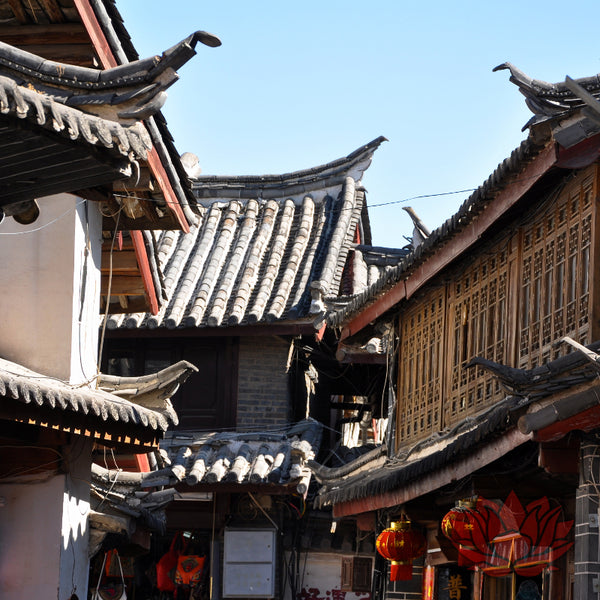

A hundred years ago modern roads and transportation methods brought an end to the Ancient Tea Horse Road and to the necessity of trading hubs like Lijiang. The Second World War however introduced a renewed necessity for this highest trade route in the world and Lijiang became a critical trading hub once again. The Chinese call this the War of Chinese People's Resistance Against Japanese Aggression. When the Japanese invaded China they came over sea from the East and blocked the Eastern seaports, effectively cut off all trading resources. The old ways and routes of the Ancient Tea Horse Road proved critical once again. It was possible to get goods from British controlled India, over the mountains to Tibet, and down into Lijiang.

How many tea laden mules followed this track over the centuries?
Before the US officially got involved in WWII a group of American fighter pilots volunteered to help defend China against the Japanese. Two squadrons were based in Kunming. They painted the noses of their planes to look like the mouths of sharks. The locals gave them the name Flying Tigers. They acted as mercenaries for hire and were quite effective at keeping Kunming out of the hands of the Japanese. After Pearl Harbor, the US officially joined the war and the Flying Tigers were absorbed into the US Military. Mules packed with tobacco and alcohol traversed The Ancient Tea Horse Road through Lijiang specifically with the allied troops in mind.
It was only a couple years ago that Kunming built their own airport. They had been using the same airport used as an allied base since WWII. Every Saturday morning we hike a local mountain that was a critical RADAR station during the war. They still use it to this day. Great fortunes were made in Lijiang during the renewed use of The Ancient Tea Horse Road. In a sad twist of historical fate with the end of the war and the re-opening of the Eastern seaports The Ancient Tea Horse Road was no longer needed. Many trading houses went out of business as the infrastructure they provided was now again made obsolete.
Lijiang's role in world history and local culture and trade was officially recognized by UNESCO in 1997 as a World Heritage Site. The quality and authenticity of the Lijiang Old Town, and the ingenious complex ancient water supply system, as well as the town's role in culture and trade were important factors in their decision. Walking through Lijiang Old Town is like walking through history… but with more tourists. We were there at the height of Chinese New Year and the town was quite literally packed. Sometimes it was hard to walk. Sadly with the granting of UNESCO World Heritage Site came profiteering. Most shops were cookie cutter clones of each other selling the exact same mass produced pink ukeleles or American Southwest style leather hats. Pink ukeleles… really?!

One legitimate nod to Lijiang's historical role were the number of shops selling puerh tea. There had to be more than a hundred. I lost count just as easily as I lost my bearings. Easily 1 in 10 stores sold puerh exclusively. Often these stores were stacked floor to ceiling in bamboo wrapped 'tong' containing 7 cakes of compressed puerh. The more I observed these stores the more I noticed some peculiar oddities. A great many stores had stacks of puerh sitting in the sunshine. I was dumbstruck. It doesn't take much knowledge of puerh to know that you don't store it in the sunshine. Puerh ages with an active bacteriological fungal fermentation and sunlight will kill it outright. At that point you have regular tea. It won't age anymore and goes stale in a couple months.

Beautiful tea tables are in such great abundance that they are used to prop up other tables.

The skill in craftsmanship of wooden goods in China always amazes me.
Most of the stores each represented a single factory or brand and carried that exclusively. Other stores were seemingly super focused on money. They had incredibly expensive interiors with elaborate furniture. We stopped in a lot of these shops to ask questions. When our questions were returned with answers we knew to be false we kept moving.
One store stood out to me. It was situated on the southern side of a quiet, dark alley running east-west. It was out of the way, but their puerh would never see sunlight. The owner looked like an old, wizened tea sage. It was hard to walk in his store because of all the stacks of puerh. He even had several stacks of puerh wrapped in the traditional methods used when packing a mule. I decided to give Mr Tang Deng Feng of Yi Chang Hao my business. We chatted with Mr Tang and told him we would like to sample his puerh and asked how much for a tasting. He assured us that anything we would give him would be plenty.


The bamboo wrapped 'tong' hold 7 cakes and weigh 2.5kg. 12 tong are stored in a bamboo basket weighing 30kg. A mule can carry 60kg of tea, or one basket of 12tong on each side. That is 168 cakes of compressed puerh tea.

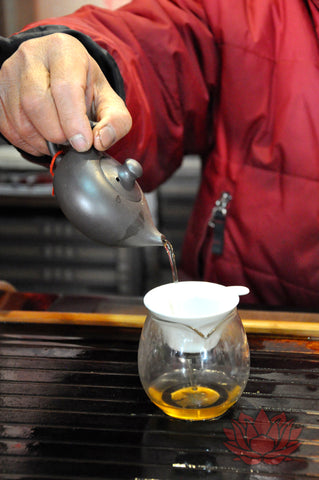
Mr Tang plies his trade with experience and skill. Notice the deeply stained wear in the tea table that has seen many years of loyal service.
Mr Tang was very pleasant and entertained us for almost 2 hours. We had some difficulty choosing which puerh to try. We explained we were there to learn and were interested in trying things that he though was special or unique. He insisted on tying our choices to the prices of the cakes as if it mattered for the tasting. We settled on a shou and a sheng both 2011 Hao Ming Mengku Shan '1973'. This would give us an idea of what the same factory and year could do for different types of puerh. I thought the cakes were a little expensive at about $25USD each. Taste-wise they were fine and all of us enjoyed the tasting and chance to pick his brain with puerh questions. I asked him why the other tea shops were storing their puerh in the sun. He said they were ignorant and the puerh they sold was fake and they were waiting on dumb tourists to pay crazy prices.

He also explained that he sourced his water from a local well called "San Yan Jing" (Three Wells). There are three pools fed from the same well. The first is used just for tea and drinking, the second pool is used for washing vegetables, and the third pool is for washing clothes. We walked by the well afterwards and the young Chinese boy who dropped his pants to urinate right next to the well didn't give me the most confidence in the quality of the water, but who am I to judge?
He showed us a really cool puerh collection. It was a collectors set from Chang Tai of 16 cakes from 16 mountains. All were picked in the same year, 2006, if I remember correctly, and produced at the same factory. Something like this is a really amazing find for a puerh collector or tea researcher. You can immediately get a snapshot of what a single year looked like for tea production. It's like when you troubleshoot a computer, you rule out everything you can and narrow in on the issue. 1 factory, 1 year, 16 mountains would give a great way to side by side sample what each mountains leaf tasted like. That opportunity from Mr Tang would set you back a cool $10,000USD. Yes, ten thousand dollars!

16 cakes, 16 mountains, 1 factory, 1 year: $10,000.
Before we left he decided to give us a special treat that would prove to be a truly eye opening experience for me. Earlier in the day a customer had come in to purchase a 2005 Chang Tai WIld Tree Early Spring Buds Sheng Puerh and they had spent the morning sampling it. The leaves had already been brewed 20 times by the time he began brewing it for us. Wow… I was immediately struck with an intense flavor of apricot. It washed over my taste buds like a tidal wave. I had never experienced a sheng puerh like that. Even after 20 brews it had a thick mouthfeel. The aftertaste was sweet and cool. It literally stuck in your throat. I could taste it for hours afterwards. I had to get some of that to bring back to the US. Mr Tang broke the news that he sold those 200g cakes individually for almost $400 USD. (upon returning to Kunming a few days later we worked a deal with some Chang Tai reps at the local wholesale tea market for a more reasonable price)
With our bellies full of delicious puerh and my mind and taste buds blown wide open with that 2005 Chang Tai we thanked him for his time and paid what we thought was a very reasonable price for the tea tasting. He was immediately visually disappointed. His face went cold and he shooed us out of his store. I was disappointed because I didn't want to upset him. I would have been interested in purchasing puerh from him if it was even remotely in the ballpark of affordability. I thought maybe I missed some cultural clue, but Lamu and her parents were also confused. We all agreed that if you tell a customer to pay whatever they want for a tea tasting you shouldn't get upset when they pay less than you expect. If you expect a certain amount, then ask for it. I'll have to keep that in mind in the future.

The Lijiang experience for me held mixed emotions. On one hand I was pleased to be able to experience a city with such rich heritage, culture, and history. The other hand I was saddened by the near lack of culture that got the town recognized as a World Heritage Site by UNESCO. All that was preserved by that recognition was the physical architecture. The Lijiang government raised the rent so high that local businesses whose culture and heritage won the UNESCO recognition in the first place were forced out. In came the foreign investors intent on lightening tourist wallets. It was disappointing.
Nothing but amazement on the puerh side though. That 2005 Chang Tai sheng puerh really opened my eyes. I immediately understood what I had previously only read about high quality sheng puerh. The way the flavor stayed with you for hours was remarkable. For that alone I was pleased with my visit to Mr Tang, even if he wasn't pleased with me.

I'll close this blog with a few pics from Tiger Leaping Gorge. Progressing closer to Tibet as puerh made its way on the backs of men and mules after leaving the relative comfort of the trading houses in Lijiang things got more treacherous. Danger presented itself at every corner, from the environment, to the landscape, to the bandits intent on cutting a quick profit with the edge of their knife. After Lijiang a few days travel would get your mule train to the mouth of Tiger Leaping Gorge. It is both beautiful and dangerous and must be passed carefully on tiny paths where one slip meant an icy death in the river below.
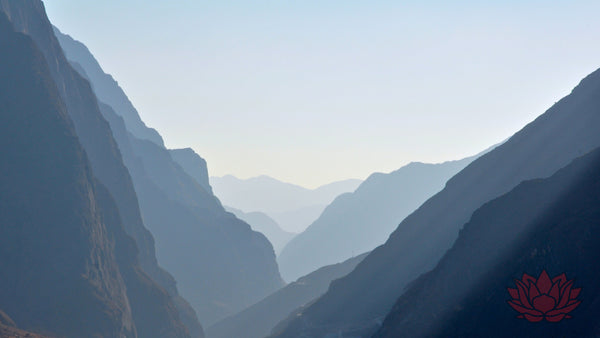
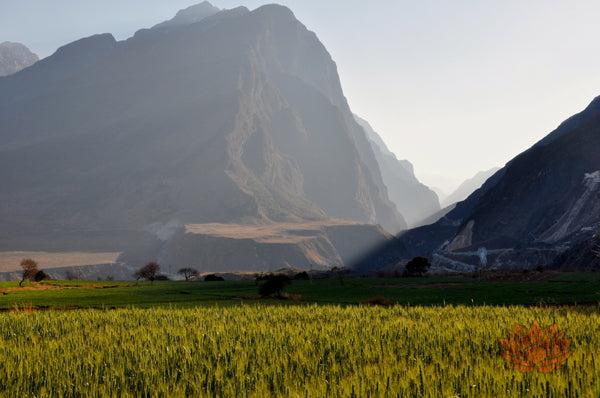

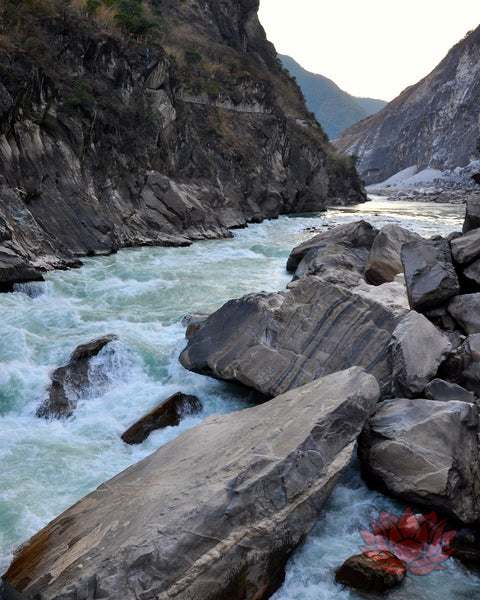
All images © Crimson Lotus Tea 2014
